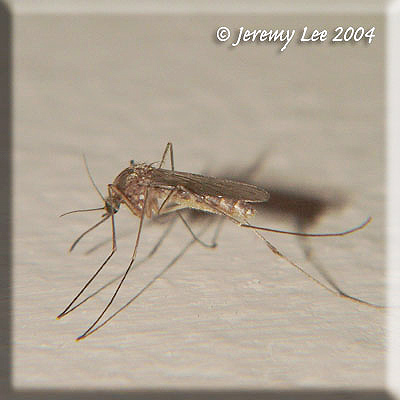
 |
|
Scientific Classifications explained » Amphibians » Ants » Aphids » Bees » Beetles » Birds » Bugs » Butterflies » Caterpillars » Damselflies » Dragonflies » Earwigs » Flies » Frog/Leafhoppers » Fungi » Galls » Grasshoppers » Harvestmen » Hoverflies » Lacewings » Ladybirds » Leaf Mines » Lichens » Mammals » Millipedes » Mosses » Moths » Sawflies » Slugs » Snails » Spiders » Trees » Wasps » Wild Flowers » Woodlice |
UK Nature > Flies > Culex pipiens

Scientific Name: Culex pipiens Common Name: Common House Mosquito Culex pipiens, more commonly known as the common house mosquito, is a species of blood-feeding mosquito of the family Culicidae. Both males and females feed on various sugar sources, such as nectar, honeydew and juices from fruits, but only females feed on blood, and will do so preferentially, over sugar, when they have mated. Blood provides proteins essential to the development of their eggs. Their primary blood meal hosts are considered to be birds, but they will feed on humans and other mammals. A real city dweller, Culex pipiens lives in urban areas in temperate zones throughout the globe. Will readily breed in any standing water, the dirtier the better. Culex pipiens f. molestus lives in the London Underground and other underground railway systems world-wide. The more common Culex pipiens subspecies observed above ground is sometimes referred to as Culex pipiens f. pipiens. |
|

https://www.uknature.co.uk is a website dedicated to showing the immense diversity of UK nature and wildlife. Our vast range of habitats, from lowland arable to snow covered mountains, from storm-ravaged coastlines to peaceful inland freshwater lakes and rivers, from dry, sandy heaths to deciduous and coniferous forests, all these habitats contribute to the abundance of UK nature. We have wild birds in huge numbers either residing or visiting our shores (597 recorded species as at July 2013) and we must also not forget the humble back garden with its grass lawns, flower beds filled with nectar rich flowers, shrubs and trees, all designed to attract huge numbers of insects such as bees, moths, butterflies and hoverflies; and finally the small ponds which provide safe havens for frogs, toads, newts and even slow worms and grass snakes. www.uknature.co.uk is the showcase for my personal passion, photographing uknature in all its glory. I sincerely hope you all enjoy the fruits of my labours. This site and all images contained therein is © Jeremy Lee 2004 - 2021. All Rights Reserved. Site design by Jeremy Lee. Site development & IT Support by Stuart Lee. |